Find a safe haven from cars on this little ribbon of biking joy along the L.A. River
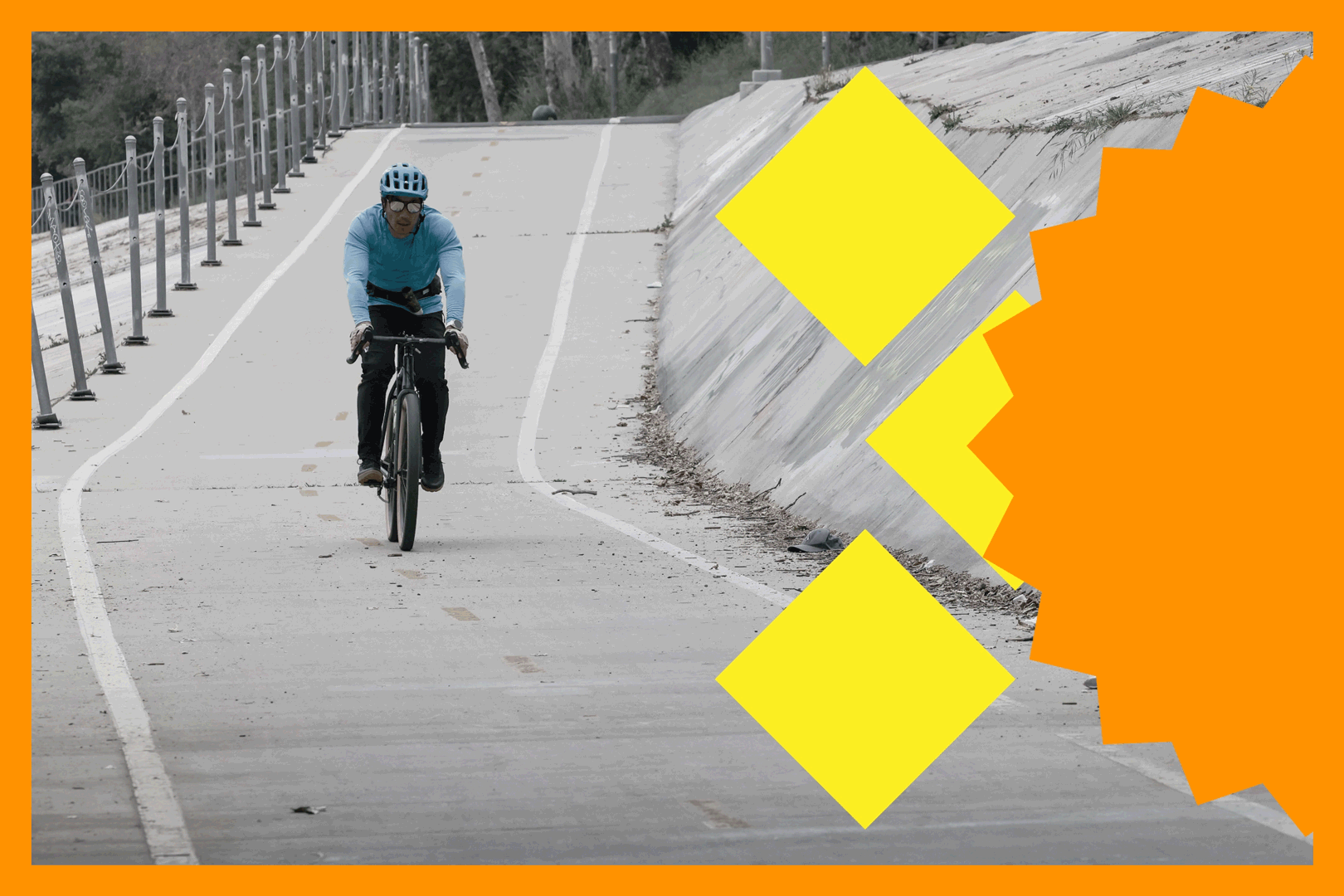
- Share via
When I lived in bike-friendly San Francisco and New York, I loved the challenge of riding with — and often in direct conflict with — traffic. But riding through the busier neighborhoods of L.A. can feel like fighting for my life, especially when an aggressive driver is on my tail. Some drivers are unfamiliar with how to coexist with bicyclists, and quite a few of our roads aren’t designed for coexistence (though that doesn’t excuse a lack of care for cyclists’ lives).
Now that I have a kid to take care of, I’m a little more cautious. I ride mostly on wide, leafy, clearly-marked Pasadena bike paths, or on Class 1 Routes, which are paths fully separated from traffic.
Get The Wild newsletter.
The essential weekly guide to enjoying the outdoors in Southern California. Insider tips on the best of our beaches, trails, parks, deserts, forests and mountains.
You may occasionally receive promotional content from the Los Angeles Times.
One of those protected routes is the Elysian Valley Bicycle & Pedestrian Path, a breezy seven-mile cruise along the L.A. River through the Glendale Narrows. My family recently strapped on helmets, saddled up on borrowed cruisers from Spoke Bicycle Cafe in Elysian Valley (a.k.a. Frogtown) and took a ride on the path with Dane Larson, the bike shop’s manager. Larson is a dedicated commuter cyclist who follows the L.A. River from home to work and back most days.
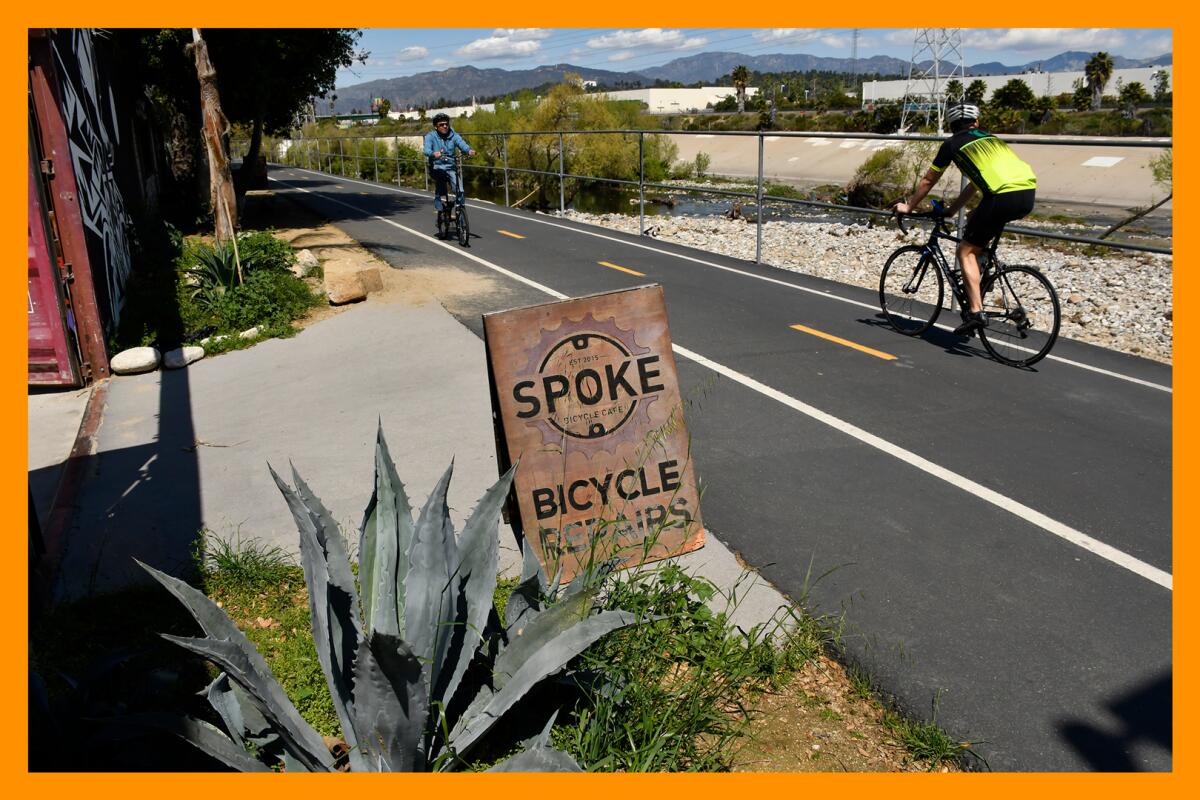
“It takes me longer to take the river, but this is a lot safer,” says Larson, who hops on his Surly Long Haul Trucker touring bike or Radpower RadMission e-bike to follow Chevy Chase to Glendale Boulevard. “It ups my commute from three to four-and-a-half miles, but the direct route is down San Fernando Road. If I take that street, I encounter the worst drivers.”
The two-lane, two-way stretch of the paved Elysian Valley bike path offers joggers, walkers, bike commuters and pleasure riders a safe haven from cars, but this little ribbon of joy also unfurls along restaurants and coffee shops aplenty. My faves are Spoke, which also serves beer and food; Loreto, which has fresh seafood; and Morning Service Coffee. You’ll pass the funky Lewis MacAdams Riverfront Park with its animal sculptures, the vibrant red Taylor Yard Bridge and daredevil haven Marsh Street Skate Park. Throughout the ride, there’s abundant bird-watching (we saw Egyptian geese and egrets on our ride). Larson regularly spots great blue herons, green herons, red-tailed hawks, great egrets, snowy egrets, cormorants, ospreys, mallards, American coots and stilts on his bike commute. You’ll even find some typically pelagic birds — those that spend most of their lives on the ocean, like gulls and pelicans.
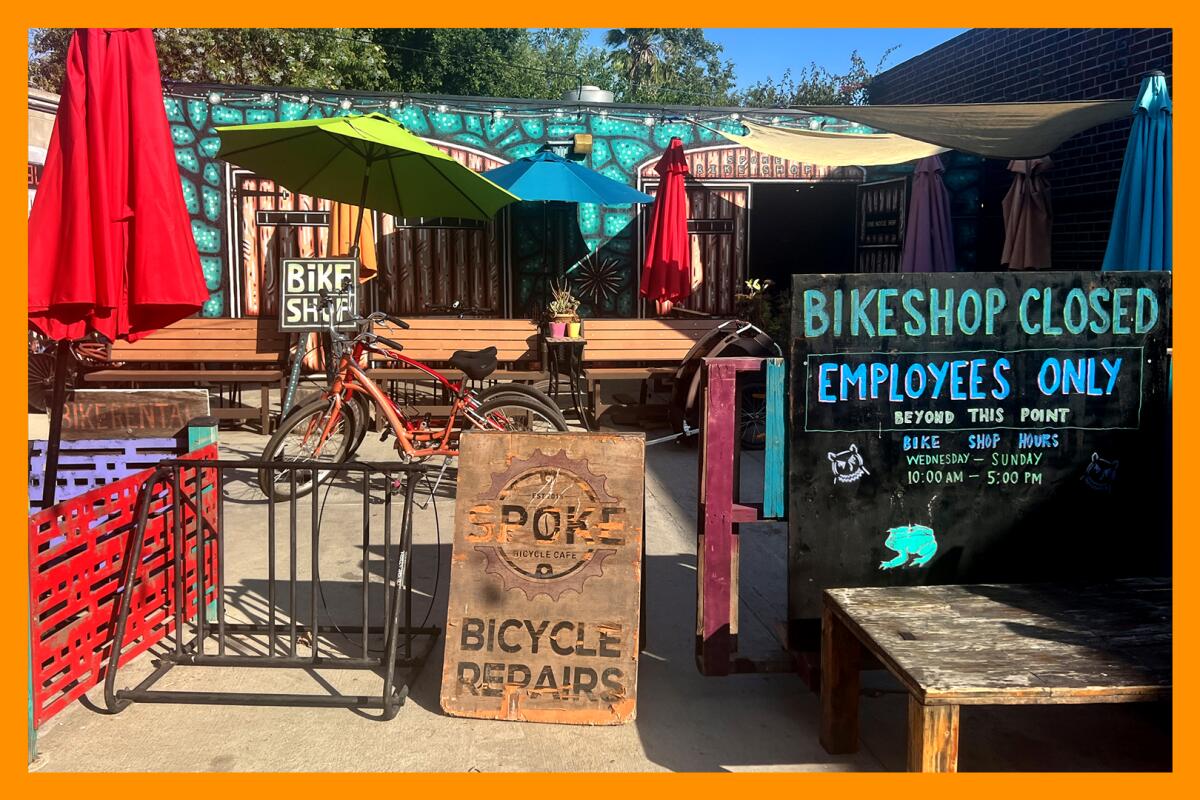
We stopped to play on the Lewis MacAdams playground with our son, passed numerous walkers and joggers and saw lots of folks lounging near the path on the grass and on concrete curbs, chatting on their phones or gazing at the birds. The vibe along the route is relaxed and breezy, thanks to partial shade offered by trees and buildings. From this protected view of bike life in L.A., it’s easy to understand how we could become a bike city.
Larson’s worked at Spoke since 2015. In addition to the two bikes he uses to alternately commute to work, he owns nine other two-wheeled creatures, which he’s ridden all over Los Angeles, from the old dirt jumps just across the Taylor Yard Bridge to our high-traffic streets.
“I go in and out of being a roadie [road cyclist] and do have a custom-built, carbon-fiber road bike, but I’m mostly a dirt nerd,” he says. On mountain trails, he prefers his tough Surly Karate Monkey and Surly Instigator, while for cyclocross, his trusty go-to is his Gunnar Crosshairs.
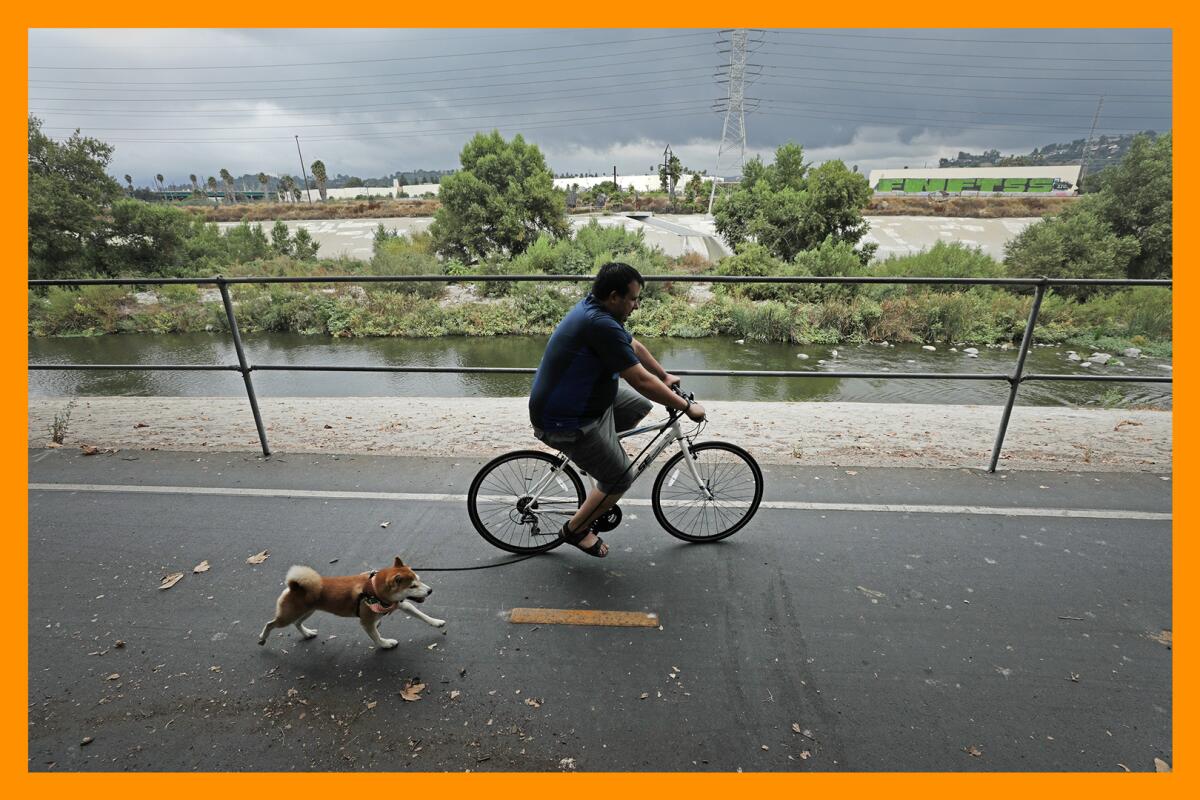
It turns out that even more exciting changes are coming to the L.A. River biking experience. Many of us only know our local segment of the river, which carves a wide path through our city (see the map). The headwaters originate in the Santa Susana Mountains near Canoga Park and flow through the San Fernando Valley, curving by Universal Studios and swooping around the north end of Griffith Park, past Silver Lake and Frogtown, downtown L.A., then on to Vernon, Bell Gardens, East Compton and finally Long Beach, where the river flows into San Pedro Bay.
A variety of bike path plans along the river are in place, and when Canoga Park is connected all the way to Long Beach, L.A. will have a 51-mile “bike highway.” As part of this effort, Metro’s L.A. River Path Project is seeking to bridge a gap between Elysian Valley and Maywood. The Los Angeles Department of Transportation and Los Angeles Bureau of Engineering are working on connecting nine San Fernando Valley gaps in what’s called the L.A. River Valley Bikeway and Greenway project; when completed, there will be 13 miles of new Valley bike paths, according to the L.A. River Master Plan. Already, progress is being made: In April of last year, a $6 million segment opened in Canoga Park, partially funded by a California State Active Transportation Program grant. But there’s more that could be done to improve Class 1 Routes and bike ridership across our city. One Times reader even proposed connecting the Ballona Creek Trail to the L.A. River path.
As Larson says, “If you build it, they will come. The more bicycle infrastructure there is, the more people will ride bicycles. One of the biggest complaints I hear is that it is that people do not feel safe riding in L.A.”
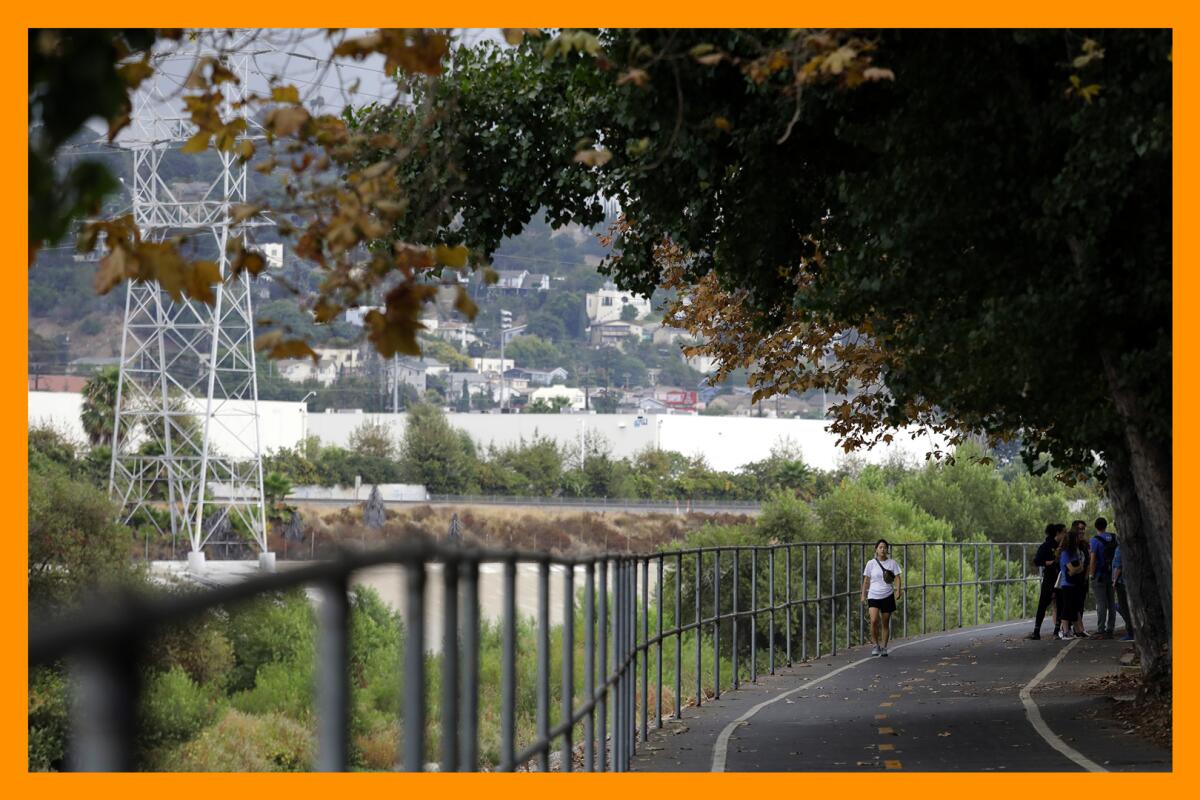
The hope for the 51-mile bike path is that it will be just one piece in a revitalization of the L.A. River and the city itself. The river offers the potential to help with flood management with proper design and planning, as well as with animal habitat restoration, health and fitness, safety from car traffic, education and even arts and culture. We’ve had a lot of conversations as a city about how important the river is to us, and how it represents who we are, literally and symbolically. But the amount of cash required to revamp it is stunning. As with Metro, I’m a firm believer that more of us need to use it in order for facilities and service to continue to improve.
So, how about an L.A. River bike ride? Ride from your home if you can, or board your bikes onto your car, Metro, Metro Micro or a bus if you can’t. See how far you can get, and where the challenges are. When my family rode, we found broken glass and litter in certain areas, which would be likely to puncture tires of the unaware.
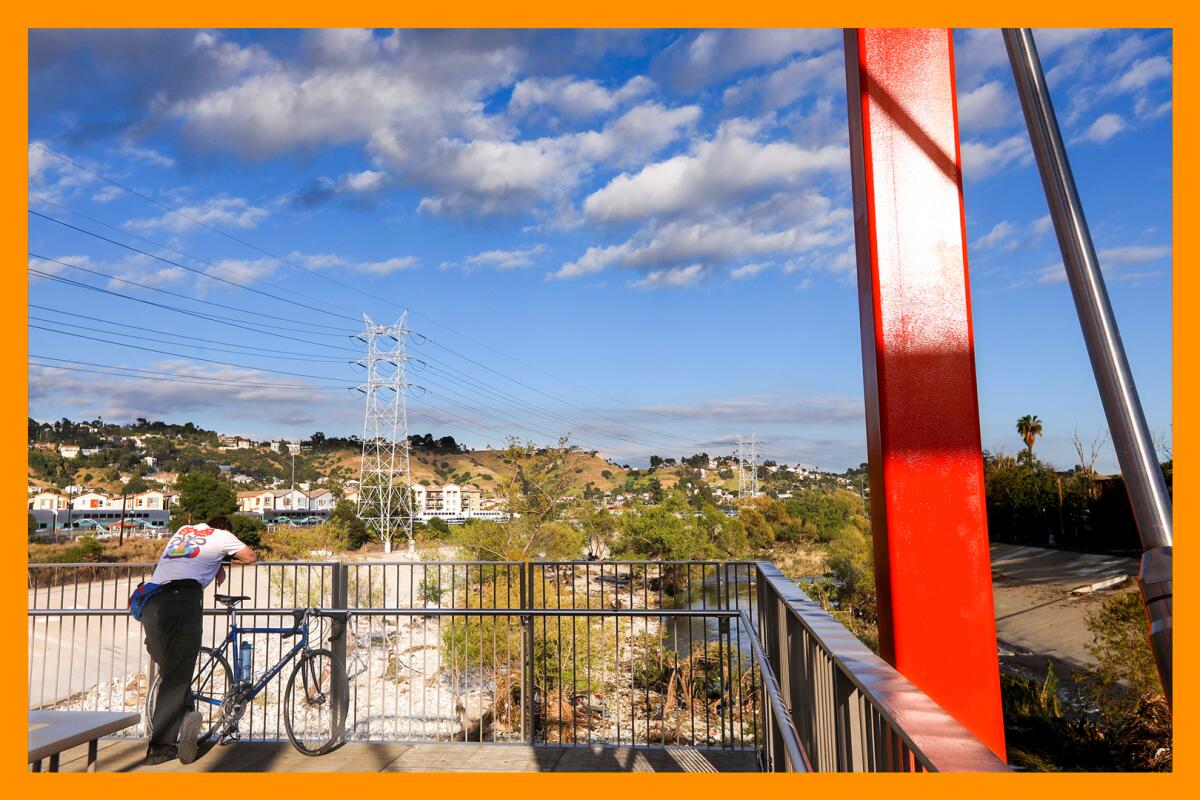
If you’d like to rent from Spoke Bicycle Cafe, bikes are available for walk-in rental, first-come, first-served. Rentals start at 10 a.m., with the last rentals at 3:45 p.m. You can rent for an hour minimum. It’s $15 an hour for a standard bicycle, and trailers for kids are an additional $15 per hour. If paid up front, each additional hour will cost you $10. Helmets are included. You’ll need to sign a liability waiver and provide collateral, like a credit card, ID or passport.
And does Spoke ever have availability, woo-hee. Pick from single-speed bikes, cruisers, sport hybrids, eight-speed road bikes, classic banana seat cruisers (small enough to work for some kids), kids’ bikes, tandem bicycles (that’s a two-person bike) or even an adult tricycle. If you’ve got a group of 10 or more, email the shop well in advance at [email protected] to make sure they have enough bikes.
To see a firsthand view of what it’s like to bike the Elysian Valley Bicycle & Pedestrian Path, check out this pure joy-riding video by Trails of SoCal. See you on the river.
3 things to do
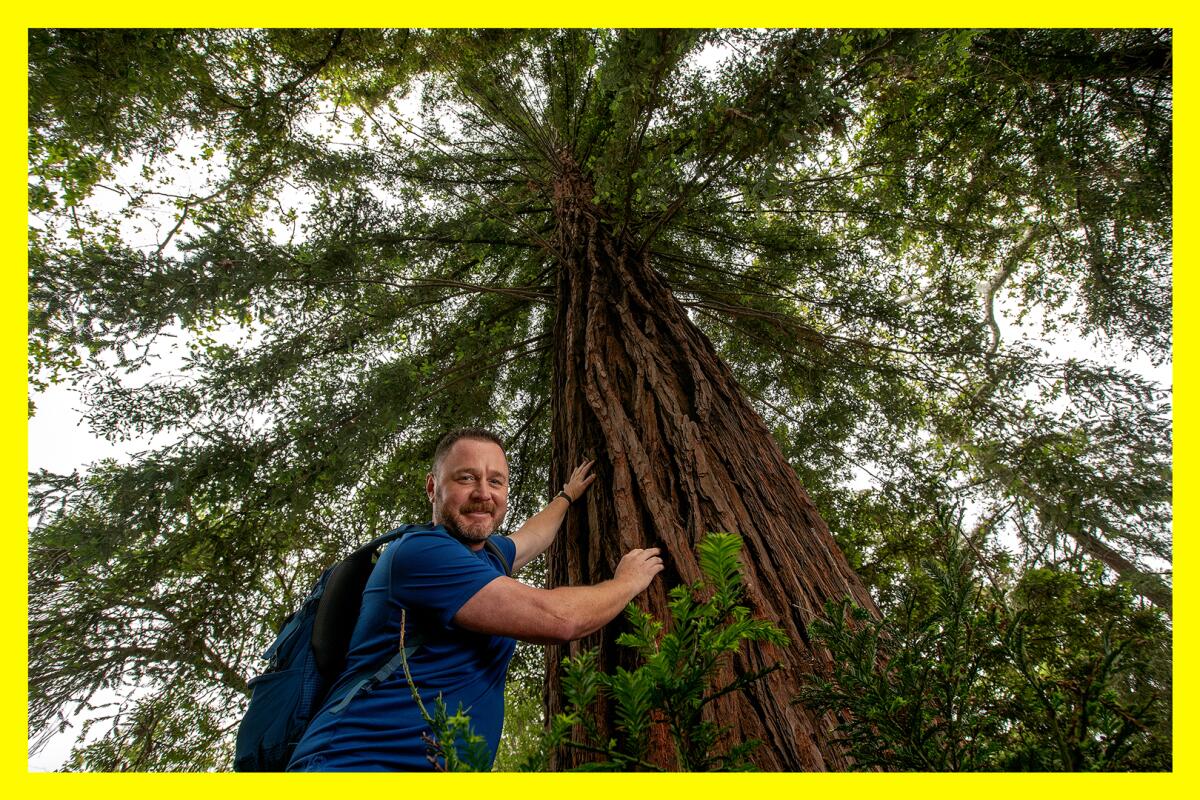
1. Eat those invasives. Tonight at Gardena Willows Wetlands Preserve from 6 to 7:30 p.m., naturalist Jason “Journeyman” Wise leads his workshop, “Invasive Plant Foraging Stroll + Food Party + Foraging ID/Recipe Guide.” You’ll learn about both native and invasive plants in our city, ID some edible plants, pick invasives and make a wild salad. Wise will lead the group on how to responsibly gather native plants in the preserve. The event costs $25 and includes a donation to the preserve; you can grab tickets here.
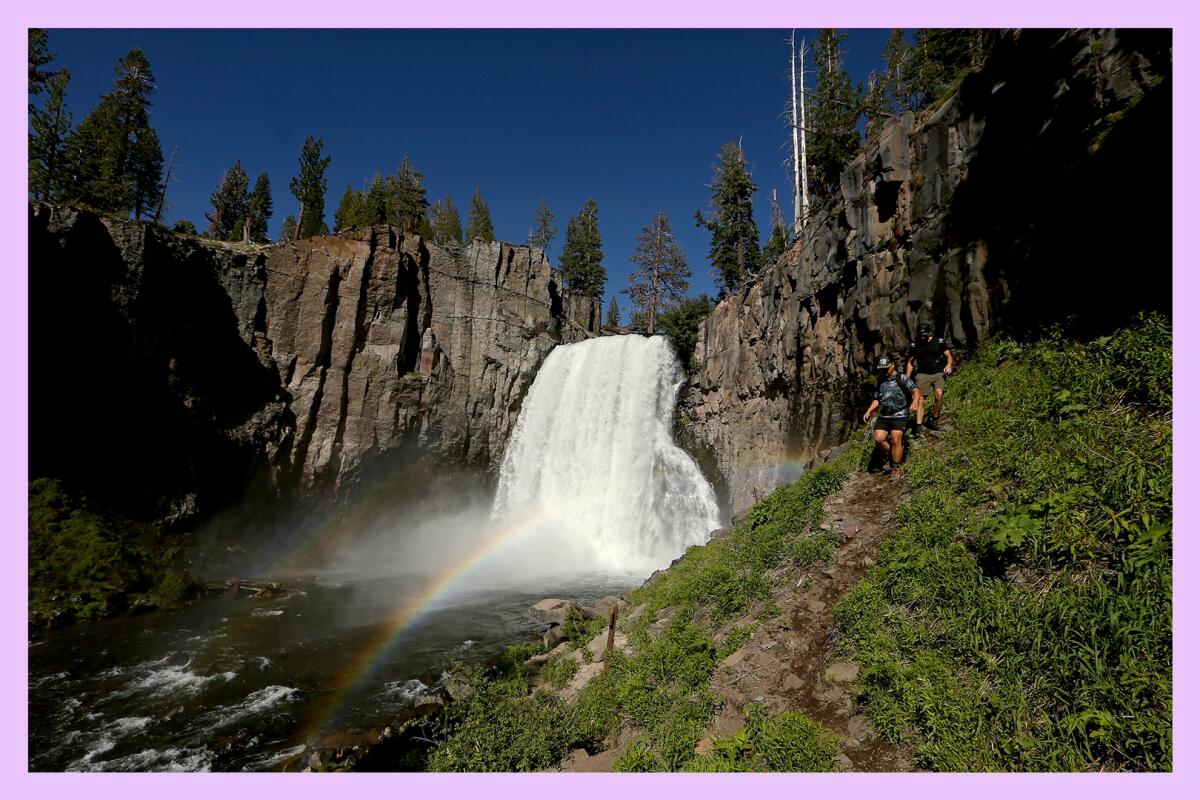
2. Hike John Muir’s fave natural spot in the world. The Palos Verdes group of the Angeles chapter of the Sierra Club is hosting a four-day, three-night backcountry hike in the Eastern Sierras from Aug. 26 to Aug. 29. You’ll leave early Saturday morning from South Bay and return Tuesday evening. To join, you have to be fit to hike five to seven miles in hilly terrain at high altitude; a medical form is required. The group will be lodging at the Quality Inn in Mammoth Lakes, and the $540 cost of the trip includes the bus and driver’s gratuity, a shared motel room (let the Sierra Club know if you need a roommate, and they’ll try to match you up), hot breakfast every morning and snacks. Visit their site for more details and for sign-up instructions.
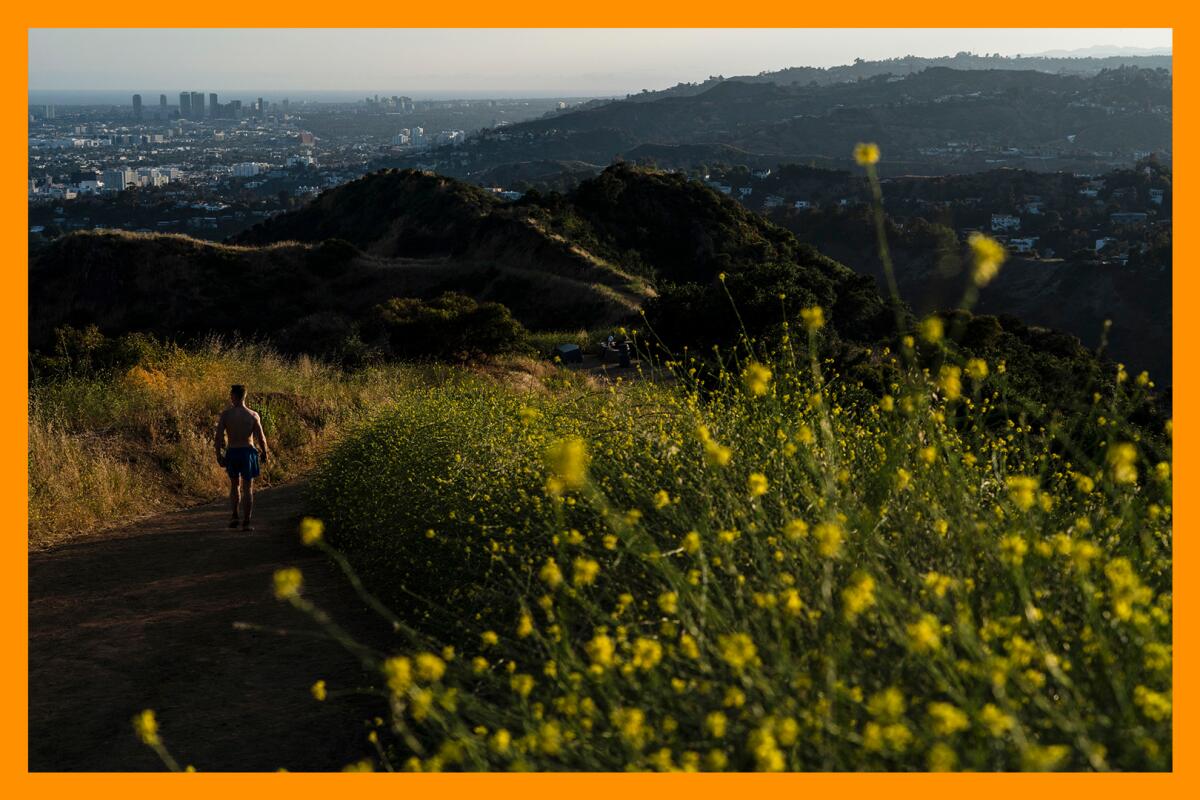
3. Team up with nature superpowers. Link up with Friends of the L.A. River, California Native Plant Society and San Fernando Valley Audubon Society for bird-watching and invasive plant removal. You’ll remove plenty of invasive mustard and learn about why its removal is important to our native habitats. Then you’ll join the SFVAS for a bird walk (binoculars will be provided). The kid-friendly event goes down Aug. 26 from 8 to 11 a.m. at the Sepulveda Basin Wildlife Reserve in Van Nuys. Bring sunscreen, snacks, a refillable water bottle and, if you want, gloves and weeding tools (some will be provided). Wear sturdy, closed-toe shoes, long pants and a long-sleeved shirt. Get your free tickets here.
The must-read
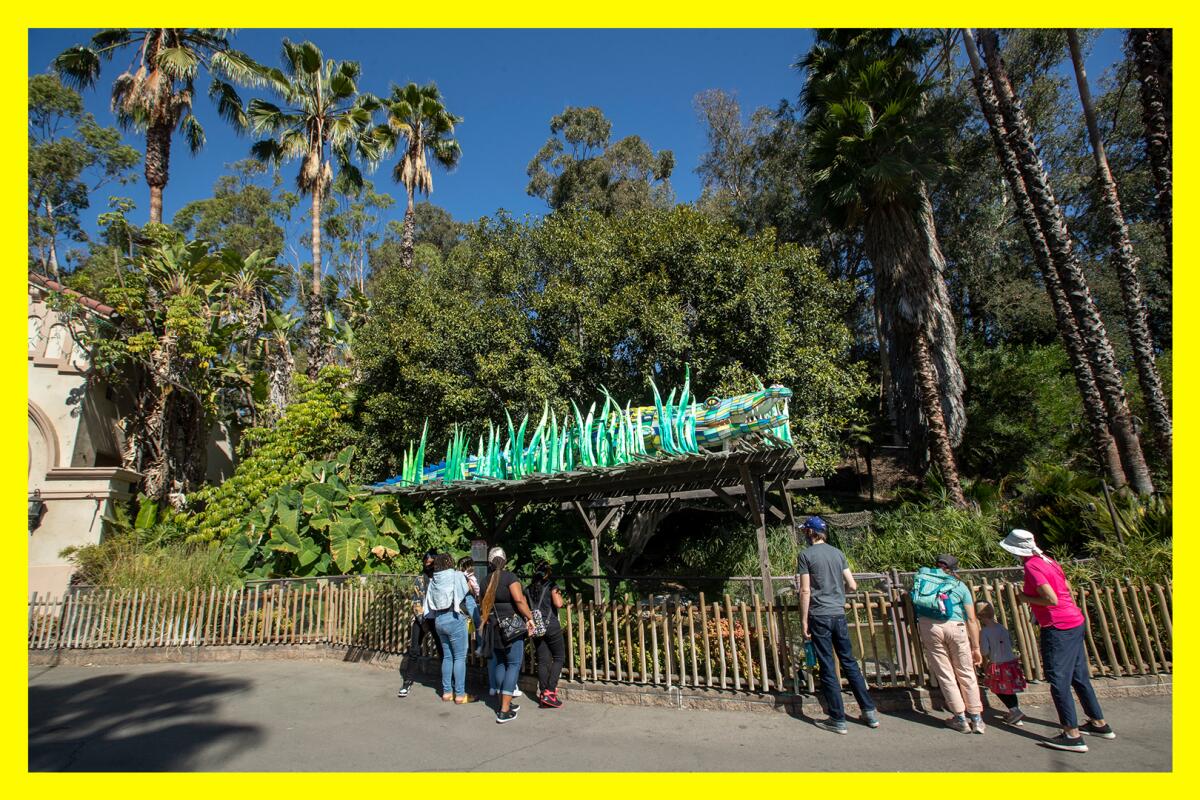
There’s been a lot of back and forth on the L.A. Zoo expansion plan over the past year, with Friends of Griffith Park recently sending out a subscribers’ email voicing frustrations with the way the proposed expansion has been pushed forward without the incorporation of public feedback. (Read more of FOGP’s thoughts here, where their response letter is linked.)
On June 28, the L.A. Zoo’s Alternative 1.5 was approved by the Neighborhoods and Community Enrichment Council Committee with only two council members present. Yesterday, the City Council voted 13-0 to certify the zoo’s environmental plan.
The lack of consideration for the public’s comments is concerning. The week before the aforementioned Neighborhoods and Community Enrichment Council Committee hearing, 350 comments were submitted to the council opposing the plan. The Sierra Club gathered 300 more opposing comments. According to FOGP, none of these comments were mentioned at the Neighborhoods and Community Enrichment Council Committee meeting.
Earlier proposals seemed outlandish, including plans to construct an aerial tram, a Yosemite National Park-style lodge and a multi-story parking garage. The revised proposal, Alternative 1.5, makes some concessions. Denise Verret, director of the Los Angeles Zoo and Botanical Gardens, wrote a letter to council members in June stating that the zoo would plan to reduce the size of its visitor center, which was initially supposed to be 15,000 square feet, and would reconsider its plans to dig 60 feet into the hills for Condor Canyon, a condor-themed artificial canyon that FOGP opposed.
FOGP says that if the Zoo had proceeded with its plans to excavate more than 74,000 cubic yards of earth and rock for an artificial canyon, it would deface the Santa Monica Mountains ridgeline that extends into Griffith Park.
The California Planning Area, where construction would take place, is the northeastern terminus of that mountain range, which extends more than 40 miles to the west. “A reconfiguration of this valuable ridgeline formation would leave one of the first significant scars on the Santa Monica Mountain Range of the 21st century,” FOGP opined. “Many lament the mistakes of the past, such as flattening the top of Mt. Lee or using Toyon Canyon as a landfill. We must not repeat these mistakes.”
In my view, the construction of a new event space called the California Visitor Center, which is still part of the proposal, seems like a questionable energy expense and space proposition. We already have numerous spaces for parties and events in Griffith Park. The undeveloped land that would be affected includes, according to FOGP, 26 trees and shrubs protected by the city.
We’ve built a city full of enormous meeting and sports venues, resulting in plentiful light and sound pollution that disturb nocturnal animals. Do we need to bring that noise and sound to Griffith Park at night, and do we need to raze all these plants at a time when global warming is accelerating?
If you have an opinion, you can still submit comments and write to and call your City Council members, or email the Zoo. It may be a done deal, but there may still be room for negotiation in terms of the finer details of the construction.
Happy adventuring,

P.S.

Here’s an exciting new opportunity: Become a community scientist by bird watching in your neighborhood for just 10 minutes a week. We know birds are sensitive to smoke, but scientists don’t have enough information about how it affects them. A new statewide project, named Project Phoenix, will help us understand more. Fostered in partnership with the UCLA La Kretz Center for California Conservation Science and the Natural History Museum of Los Angeles County, the study aims to cover all of California — in other words, the more volunteers, the better. The project starts in August and extends through October. Beginner birders are strongly encouraged to participate. Get more info and sign up here.
For more insider tips on Southern California’s beaches, trails and parks, check out past editions of The Wild. And to view this newsletter in your browser, click here.
Sign up for The Wild
We’ll help you find the best places to hike, bike and run, as well as the perfect silent spots for meditation and yoga.
You may occasionally receive promotional content from the Los Angeles Times.




